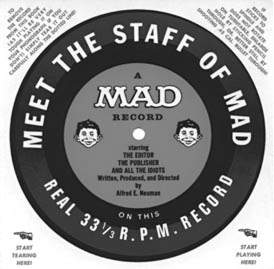![]()
Some food packaging oriented flexis were items like the tops of frozen food containers, tops of Borden cottage cheese, tops of margarine tubs and flexi-discs included inside boxes of Quaker granola bars. TOPPS, the company known for baseball cards, sold flexi picture records of Motown stars in the late 60ís that included a stick of bubble gum from candy stores for fifteen cents.
 American
Audiographics was one of the last major manufactures to do a booming business
in this now dead medium. They made records for a wide range of business
and industry promo needs and featured great pictures and graphics. One
of their last products in high demand were flexi picture records in the
pages of B grade porn magazines featuring laughable recordings of guys
and girls getting it on. Who could forget "Sugar Sugar" by the Archies?
American
Audiographics was one of the last major manufactures to do a booming business
in this now dead medium. They made records for a wide range of business
and industry promo needs and featured great pictures and graphics. One
of their last products in high demand were flexi picture records in the
pages of B grade porn magazines featuring laughable recordings of guys
and girls getting it on. Who could forget "Sugar Sugar" by the Archies?
AMERICAN AUDIOGRAPHICS was the manufacturer of many of the infamous cereal box records made in the 60ís and 70ís that brought woe to so many parentsí HI FI stereos. Cereal boxes with record premiums as a ploy to get kids to hound their parents to death so they will buy a certain brand was nothing new when I partook in the ritual in the late 60ís. Records were not only attached to the outside of the boxes, but also included inside "specially marked boxes" too. Wheaties had done this a generation before mine in the 1950ís with records on the box as well as giving the consumer the ability to mail in proof of purchases and get records through the mail.
Click picture for a larger version
While there are many other makers through the history of flexi-discs, many of these records bear no mention of a maker. Certain items retain the trademarks of sub-contracting deals but there are many one of a kind items that have no mention of manufacturer.
Some of the other applications in the nearly 100 year history of the flexi are contest records that invited the listener to participate, promos that were tie ins to stores to entice customers, fan club give-aways, political messages, movie and album promos, event souvenirs, childrenís songs, personal recordings, religious messages, holiday recordings, WWII soldiers record letters, zodiac records, greeting cards, fast food give-aways and cartoon character records. Some of this stuff defies categorization but always pushes the envelope of record uses in some way.
One of the aspects that I find really appealing about these records is that this format, this little floppy thing, is probably the only way this sound artifact exists. Unless some nut like me has the self indulgent audacity to produce a CD, the only way to hear it is to mange to play it. I say manage because there are many tricks using various combinations of coins, rubber bands, tape and strong breaths of air that are needed to get these records to play.
Then there are the entire areas of toys with records, oddity records and self amplified units that take the idea of playing back sound to another levelÖ but those will have to be for another time. So there it is! A little overview of the obscure world of flexi-discs. The next time you see one, perhaps allow yourself to take it home and keep it to remind yourself of one bizarre artifact from our recorded history. But be careful, you may get caught up in a world from where you may never return.
MAC curates the virtual museum of flexi / cardboard / oddity records where you can see and hear many more of these artifacts at www.wfmu.org/MACrec.